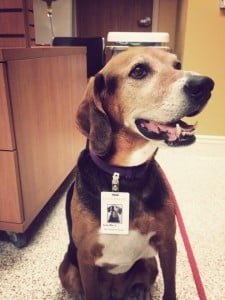We are strong advocates of rescuing dogs. Some argue that older rescue dogs come with more issues than getting a new puppy, but in our experience, most rescue dogs are friendly, easily trainable, and can quickly become excellent companions.

Lucille was adopted at the age of 5 from the Oakville/Milton Humane Society. After completing Foundation Skills and Canine Good Neighbour classes, she recently passed her St. John’s Therapy Dog exam! Here she is pictured at work with her therapy dog ID badge.
A common question we are asked is, “What should I do once my rescue dog comes home?”
Here are five recommendations for new rescue dog owners.
- Keep it quiet: We know that getting a new dog is exciting and you want to show them off to everyone you know, but it’s crucial for your new dog to have a quiet first week. They are adapting to a new environment, new schedule, new everything – that’s already a lot of stress. They don’t need to be overwhelmed by extra stressors, such as dozens of visitors there to see them, or to be taken to a dozen new places within the first few days of being with you.
- Create a “Safe Place”: Make sure your home is ready for your new dog by putting away potential destructive chewing items like shoes, and socks on the floor. Remove accessible food from the counter to prevent counter surfing. Ensure your dog has a safe place to hang out in, whether it’s a crate, an exercise pen, or an area of the house closed off by baby gates. You can put their toys there, have a bed ready, and make sure it’s dog proofed for when they need to be confined.
- Practice short departures: Some people will take time off work or bring their dog home on a weekend when they have lots of time to dedicate to their transition, but remember your dog needs to get used to being alone because for many the work week is coming! While it’s good to have some flexibility when your new dog arrives, don’t spend every hour by their side. Give them a meal in a food dispensing toy or freeze some wet food/peanut butter in a kong and while they’re engaged with it, step out for a couple of minutes, do a short errand, or go for a run. Get them used to departures as a time of relaxation associated with a high value food reward.
- Set them up to succeed: Instead of trying to test your dog’s skills by putting them in situations they may not be ready for, work on reinforcing the behaviours you want to see in your dog. For example, instead of taking your dog off leash to see what their recall is like (and have them run away), try them on a long line (20 to 30 foot leash) and reward them for returning to you. Work up to off leash activity. Don’t take chances with your dog’s behaviour as they are still new to you.
- Implement safety protocols: Many new rescue dogs are lost and never found again within days of adoption – they slip their collars and bolt, jump over a low gate, or squeeze through a front door and bolt. Make sure your dog’s collar is fit appropriately (only 2 fingers should fit in between the collar and their neck) and their harness is fit equally as snug. Review the safety of your yard and monitor their time there – dogs can dig out, or squeeze through small gaps. Crate or leash your new dog if you need to answer your front door.
Once your dog has settled in and is used to your routine, you can start to be able to predict how they will respond in situations and really get to know your new dog. Once that’s happened, you should sign them up for a group class to improve their manners and to develop a bond with your new addition.
